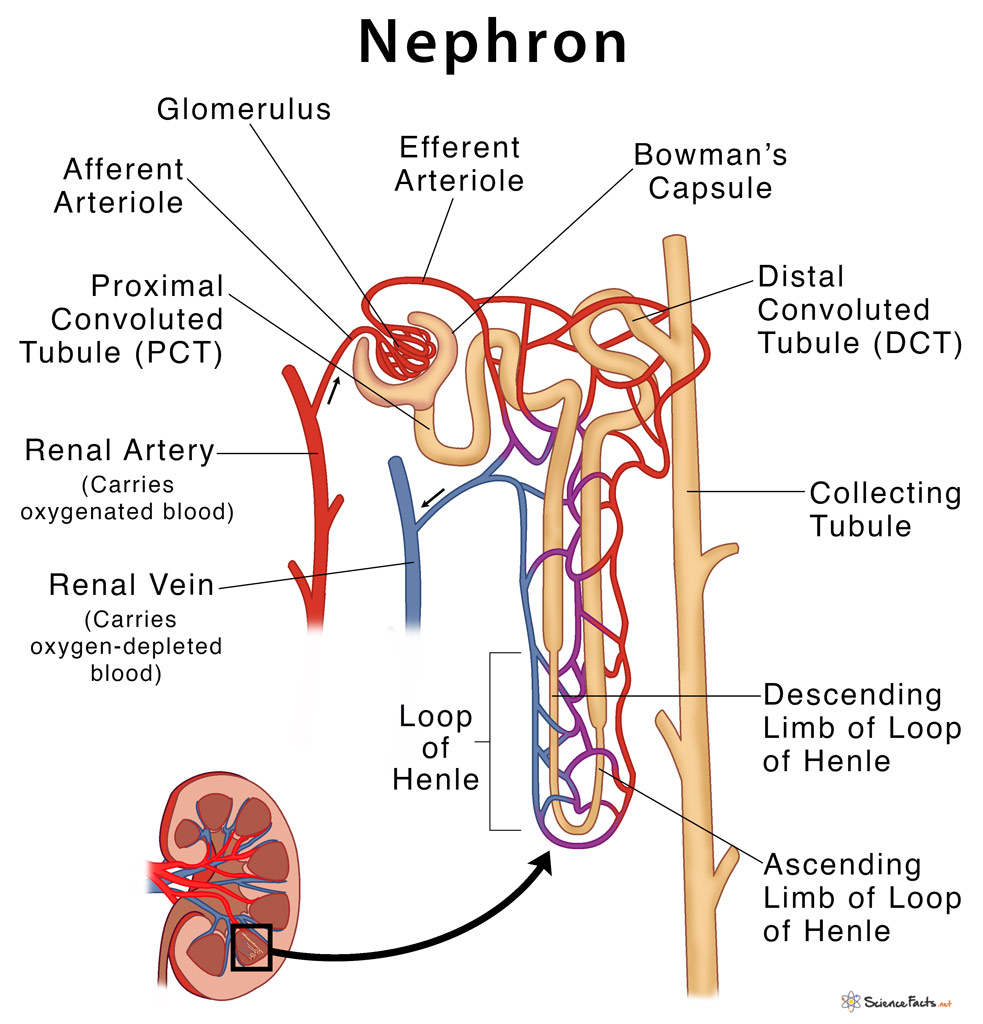Nephron
What is a Nephron
A nephron is the unit of structure and function in the kidney. Each nephron is a coiled tube held together by a tough fibrous connective tissue. In humans, a healthy adult has 1 to 1.5 million nephrons in each kidney, functioning together to filter blood from all its impurities. They also regulate blood pressure, control electrolytes, and regulate blood pH.
Where Are They Located
The most advanced nephrons occur in the kidneys of adult land vertebrates, such as reptiles, birds, and mammals, whereas those found in amphibians and most fishes are less advanced. The most primitive nephrons are located in the kidneys of primitive fish, amphibian larvae, and embryos of advanced vertebrates.
Structure of Nephron
Under the microscope, each nephronis a long, extremely fine tube, about 30–55 mm (1.2–2.2 inches) long having several components and sub-components.
Parts and Their Functions
It consists of three parts: 1) renal corpuscle, 2) renal tubule, and 3) collecting tubule with the first two being the main parts, and the third an accessory part. Within the kidney, both the renal corpuscle and the renal tubule are located in the cortex, whereas the collective tubule is found in the medulla.
1) Renal Corpuscles
Also known as Malpighian corpuscle, it is the beginning of the nephron, containing the initial filtering units and is composed of two parts:
a) Glomerulus: It is a network or tuft of filtering capillaries enclosed within a cup-shaped pouch called the Bowman’s capsule. It is formed from two types of capillaries called afferent and efferent arterioles. The afferent arteriole brings blood into the glomerulus, while the efferent arteriole collects blood and takes them away from the glomerulus. The glomerular blood pressure provides the force for water and solutes to be filtered out of the blood plasma, and into the Bowman’s capsule, a process known as ultrafiltration.
b) Bowman’s capsule: Also known as the glomerular capsule, it is like a double-walled cup that surrounds the glomerulus. It is made of a visceral inner layer formed by specialized cells called podocytes, and an outer layer composed of flattened epithelial cells. It channelizes the filtered materials obtained from the glomerulus, containing ions and small molecules, to the next part, the proximal convoluted tubule. The remaining blood is carried away through the efferent arteriole.
2) Renal Tubule
It is the secretory part of the nephron lined with ciliated epithelial cells. The renal tubule helps in processing and carrying away the filtered fluid and iscomposed of four main components:
a) Proximal Convoluted Tubule (PCT): Lies next to the Bowman‘s capsule, it can be divided into an initial convoluted portion followed by astraight (descending) portion. It is a wide tube lined with a layer of columnar epithelial cells with brush border or microvilli that greatly increases the surface area of absorption. PCT maintains the electrolyte and acid-base balance of the body fluids. It receives the filtrate coming from the Bowman’s capsule.Most of the essential solutes and substances, like glucose, proteins, amino acids, a major portion of electrolytes, and water, are reabsorbed here in a process known as tubular reabsorption. It also secretes ions of hydrogen, ammonia, creatinine, and potassium into the filtrate through tubular secretion, and absorbs HCO3–from it.
b) Loop of Henle: Also known as the nephron loop, it is a U-shaped segment that begins in the cortex of kidney, receiving filtered material from the proximal convoluted tubule, extending into the medulla, and then returning back to the cortex to empty into the distal convoluted tubule. Its primary role is to concentrate the ionsin the interstitium, the fluid-filled tissue surrounding the Henle’s loop. The Henle’s loop consists of two distinct regions:
- Descending Limb of Loop of Henle: It is the descending part that is permeable to water but completely impermeable to salts. This results in the concentration of fluid as it descends deeper into the interstitium.
- Ascending Limb of Loop of Henle: It is the ascending part that runs parallel to the descending limb but is impermeable to water. The ascending limb functions to pump sodium out of the filtrate, increasing the interstitial fluid concentration.
This filtrate with low salt concentration is passed to the distal convoluted tubule, the next part of the nephron.
c) Distal Convoluted Tubule (DCT): Lies next to the glomerulus and similar to PCT, it secretes ions such as hydrogen, potassium, and NH3 into the filtered material while reabsorbing the HCO3–. Sodium ions along with water are reabsorbed in the DCT utilizing cellular energy and in presence of hormones. Thus DCT helps to maintain the pH and sodium-potassium levels in the blood.
3) Collecting Tubule
This is the first segment of a system of collecting ducts that receives the output of the renal tubule. The system of collecting duct consists of a long straight tube lined with simple cuboidal epithelium, and helps in reabsorption of almost three-fourths of the water from urine. As a result, the urine leaving the collecting duct for excretion is highly concentrated.
Types of Nephron
Based on their location and the length of Henle’s loop, mammalian nephron is of following two types:
- Cortical Nephron: Comprises 85% of the nephrons in the human kidney. Cortical nephrons start high in the cortex that does not penetrate deep into the medulla and has a characteristic short Henle’s loop.
- Juxtamedullary Nephrons: Comprises the rest 15% of the nephrons in the human kidney, they start low in the cortex near the medulla and are found to have a long Henle’s loop. These are found only in birds and mammals.
FAQs
Ans. Reabsorption, active transport, secretion, salt pumping, and filtration are the selective processes occurring in the nephron. Amongst all, filtration is the least selective of all processes.
-
References
Article was last reviewed on Thursday, February 2, 2023




